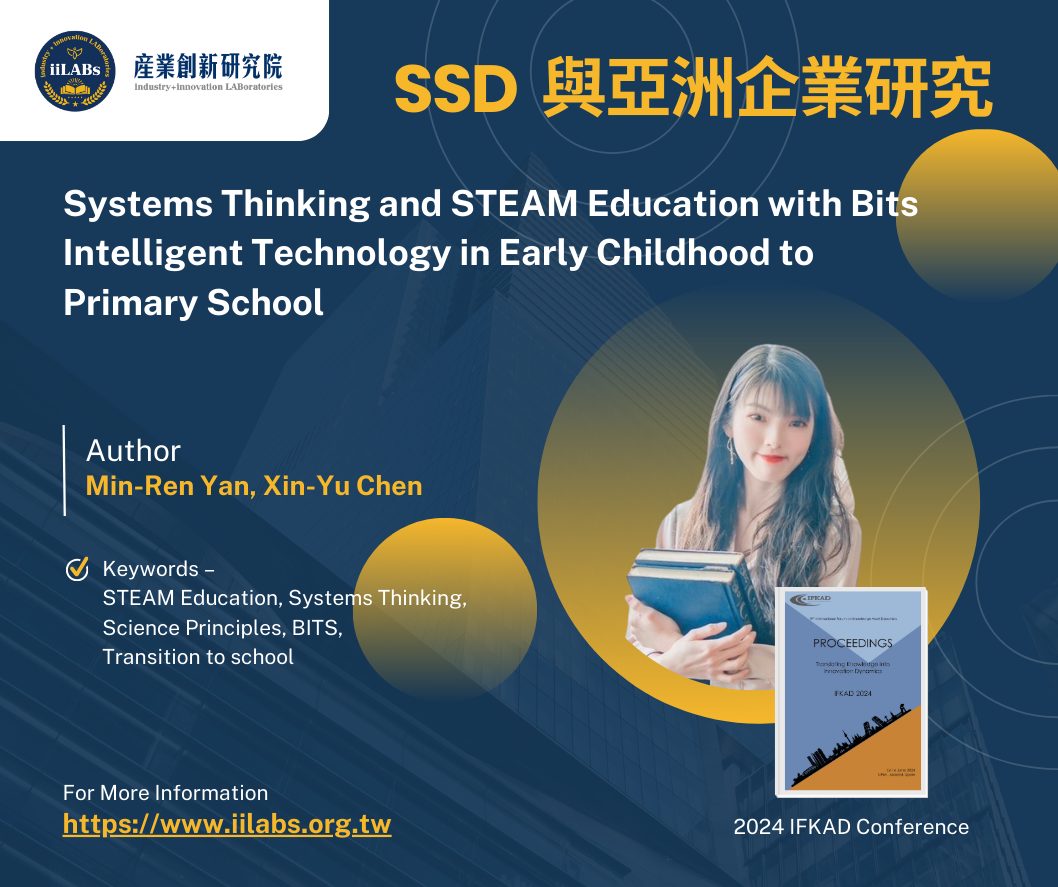


📙論文名稱:
Systems Thinking and STEAM Education with Bits Intelligent Technology in Early Childhood to Primary School
📙刊登處:2024 IFKAD國際學術研討會
📙作者姓名: Min-Ren Yan, Xin-Yu Chen
論文摘要:
Education through STEAM is a trending topic nowadays. nowadays, originating from the 5 elements of American Education "STEAM": science, technology, engineering, art and mathematics. Using systems thinking pattern to help children via STEAM education and BITS to construct the concept and knowledge of science principle, through practice to con next learned material with smart technology, learning while doing, repetitive practice, collaborative learning, small muscle training hand-eye coordination, activating logical thinking to analyze and resolve problems.
The idea and purpose of the BITS course materials attribute to "create" a safer environment, enhance children attention and willing of learning, forming a children-centered mindset. Therefore, applying 3D printing to build material sets and electronic parts, which is appr opiate for the usage in teaching condition because of its convenience. The teacher of each cl asses could use it to introduce the concept and knowledge of science principle, demonstrate the proper way to use teaching materials and allow children to learn multiple domains application in elementary school or kindergarten.
It is presented in the form of a questionnaire investigation approach to understand the practical teaching and operation of Bits teaching materials on site and uses the five characteristics of systematic thinking to integrate the cross-field teaching model of kindergartens and elementary schools, forming a comprehensive teaching structure with systematic, plan need integrity, structure, three-dimensional, and dynamic in teaching practice.
The kindergarten part will be implemented in accordance with the policies of the Minis try of Education's "Kindergarten Education and Protection Activities Curriculum" and "Kindergarten Curriculum and Teaching Quality Evaluation Form". The part will cooperate with the 108-curriculum policy and be integrated into the science area of the kindergarten learning area and the national elementary school. The “STEAM education course time” ca n attract children to try operations from the scientific principles in daily life application in elementary school clubs, such as “understanding the principle of positive” “negative p ole operation of magnets”” understanding the implementation of LED light and shadow changes”and “understanding the implementation of the principles of sensor and speaker sound production”.
The purpose of this study is mainly the modern adaptation of education model, with the promotion of systems thinking pattern applied on the practice of STEAM education, focusing on the students, instead of the traditional teacher-centered way of teaching, making the children willing to take the initiative in learning and henceforth make new applications of the BITS course materials.
In summary, this systems thinking-based BITS teaching material serves as an introductory version suitable for early childhood education and can be extended to cater to elementary school middle and high-grade levels, aligning with the 108 Curriculum for advanced natural science courses. It provides a versatile platform for children, allowing them to deepen their understanding through hands-on activities and aiming to enhance the memorability of classroom lessons. The primary objective is to transform the learning experience, ensuring that the acquisition of new knowledge is no longer perceived as dull or tedious.
The anticipated research outcomes demonstrate that the smooth transition from early childhood to primary education allows children to clearly understand how to operate within a STEAM-integrated interdisciplinary learning framework. Engaging with BITS teaching materials fosters systematic development of creativity, collaboration, communication, autonomy, and problem-solving abilities. This approach can integrate the six major domains objectives of early childhood education curriculum and the technology objectives of the 108 Curriculum, effectively incorporating them into instructional practices as meaningful and repeatable teaching resources.